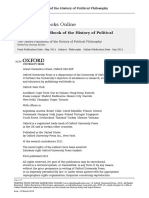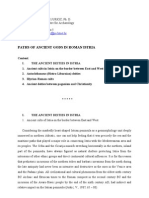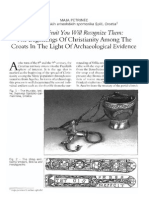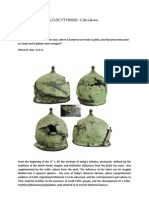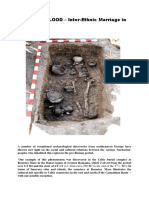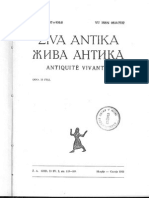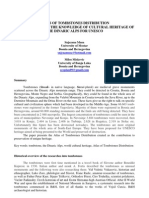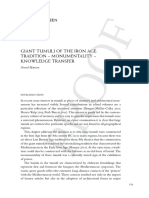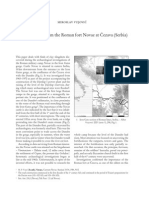Kibela Ciglenecki
Kibela Ciglenecki
Uploaded by
nedaoooCopyright:
Available Formats
Kibela Ciglenecki
Kibela Ciglenecki
Uploaded by
nedaoooOriginal Description:
Original Title
Copyright
Available Formats
Share this document
Did you find this document useful?
Is this content inappropriate?
Copyright:
Available Formats
Kibela Ciglenecki
Kibela Ciglenecki
Uploaded by
nedaoooCopyright:
Available Formats
21 - 31
Late Traces of the Cults of Cybele and Attis.
The Origins of the Kurenti and of the Pinewood
Marriage (Borovo Gostvanje)
1 9 9 9,
Slavko Cigleneki
S L A V I C A
II
The carnival mask of the kurent invokes the memory of the mythical companions of
Cybele and Attis, who played an important role directly before Christianity became the prevailing religion throughout the territory of present-day Slovenia. It also seems that pinewood marriage (borovo gostvanje), an event that takes place during the carnival festivities, reflects one
of the high points of the March celebrations dedicated to Attis. The author further mentions
some additional elements of the heritage which have preserved the elements of the Great Mother
cult as late as the Middle Ages and even into modern times.
S T U D I A
M Y T H O L O G I C A
There are numerous carnivals masks and traditions that originated during the preSlavic period. In his excellent, although almost unnoticed 1978 study concerning the mask
of the hind, Niko Kuret emphasizes the pre-Slavic origin of this mask and presents the
phenomenon of the survival of individual elements of pagan cults all through to the present
(Kuret 1978). Kuret perceives in the hind the survival of an older cult figure worshipped by
indigenous inhabitants that lived in the territory of present-day Slovenia and amidst the
confusion of migrations, took to almost inaccessible areas of southeastern Noricum (Kuret
1978, 502). Here I would like to draw attention to the roots of the kurent (korant) from
Ptujsko polje and the custom of pinewood marriage (borovo gostvanje) in Prekmurje which
can be traced to an important cult which was practiced in Slovenia during the Roman era.
A comprehensive review of masks in Slovenia maintains numerous attempts at explaining the figure of the kurent (Kuret 1984, 192-196) by ethnologists and linguists: their
explanations tied it with the Slavs, the Uskoki, the Illyrians, the Greeks, the Latin peoples
and all the way to the East Finns/Mongolians. The most renowned expert on masks in
Slovenia, the late Niko Kuret, wrote in 1984 that the figure of the kurent remains a mystery
(Kuret 1984, 193).
In a booklet, published in 1978 on the new collection of the Ptuj museum . Cobelj
proposes yet another thesis concerning the origins of the kurent; from the point of view of
this article she comes nearest to the solution of this enigma (Cobelj 1978, 9-10). Cobelj
indicates that the origins of the kurent are related to the Kuretes, Greek demons who
protected the young Zeus in a cave from his father Cronus by banging their swords against
their shields and thus creating a great din, to drown the childs crying.
This thesis was not welcomed by experts in the field. F. Bezlaj, for instance, termed it
unpersuasive (Bezlaj 1982, 113), while N. Kuret felt that this comparison was forced, especially the part which linked the swords of the warriors from Crete with the hedgehog clubs
of the kurenti (Kuret 1984, 196). Since the meager economic connections between the
21
Late Traces of the Cults of Cybele and Attis
present-day Slovene territory and Greece could not justify the transmission of this tradition
in a satisfactory manner, the presumption about the links between the kurent and the Kuretes
and the Koribantes from Crete was not convincing enough. . Cobelj compared the kurent
only to the Kuretes from Crete (or to the Koribantes), but did not emphasize the role of the
latter in connection with Cybele, the goddess from Asia Minor. Nor did she realize the
connection between the cult of Cybele and the Slovene territory, despite the fact that two of
the most beautiful depictions of the goddess in the Roman provinces had been found in the
very town of Ptuj (comp. Modrijan, Weber
1979-1981, 95-97, and Abrami 1925, 188189).
The current and different understanding of Slovene ethnogenesis is of some significance; the varying views concerning settlement patterns at the time the Slavs
reached this territory had a havy influence
upon varying interpretations of the kurent
figure. Until very recently it was commonly
believed that at the end of the 6th century
the Slavs migrated to a more or less empty
territory with but a few fragments of the remaining indigenous inhabitants (comp.
Grafenauer 1978, 230-233). The large majority of older researchers therefore looked
for analogies for the kurent mainly in the
heritage of the peoples who had settled in
this area after the decline of the Roman
Empire.
Numerous fortified settlements, some
of which had already been researched, indicate that the present-day Slovenia was still
settled during the Late Roman era, however
mostly in the hilly and remote areas far from
1. The front of a damaged altar dedicated to Cybele
valleys of transit. This is where the indifeaturing symbols of the goddess and Attis; from
Marof near Jurkloter. The central part of the surface
genous inhabitants spent the dangerous pedepicts a pine tree with different musical instruments
riod of the great migrations, meeting new
(a Phrygian f lute, panpipes, tambourine, and
settlers with which they merged during the
cymbals)hanging from its branches and Attiscap,
following centuries; this process remains
adorned with stars. The tree with instruments
(symbols of Attis) grows from a wall-shaped crown
very vague. Two such indigenous areas have
between two reclining lions (symbols of Cybele).
been discovered in the vicinity of Ptuj: south
of Donaka gora and Bo with Kozjansko
at its center (Cigleneki 1992), and the southeastern slopes of Pohorje (Strmnik 1997).
Even though indigenous settlements have yet to be found in Slovenske gorice or in Haloze,
these two areas cannot be completely ruled out as possible refuge territories.
The second significant element which should be taken into account when attempting
an explanation of the individual fragments of folk culture and tradition is the much more
important role of the cult of the Great Mother at the end of the Roman era; that is during
22
Slavko Cigleneki
the critical time when Christianity prevailed over paganism. Many items which shall be
mentioned later on confirm the existence of the elements of this cult in folk culture long
into the Middle Ages, and in some forms - though sometimes largely transformed - even up
to the present. One should of course also bear in mind a specter of the remaining pagan
cults which had been only seemingly abruptly replaced by Christianity; in reality this was a
very gradual process, and in some places it has never occurred on the whole.
While studying the Roman monuments that are dedicated to the cult of Cybele
(Kybela) and which have been preserved in
Slovenia, a hitherto overlooked possibility
of explaining the figure of the kurent as well
as the carnivals custom of pinewood marriage (borovo gostvanje) in Prekmurje in
a different manner surfaced (Cigleneki
1998a and Cigleneki 1998b). A gradually
increasing number of monuments dedicated
to this cult enhances the knowledge which
is further supplemented by the elements of
folk tradition in Slovenia as well as by individual finds from neighbouring and also
more distant lands.
In the territory of present-day Slovenia
the cult of Cybele was concentrated around
the Roman towns of Emona, Celeia, and
Petoviona; individual monuments were also
discovered at Ig, Marof near Jurkloter,
Podkraj near Hrastnik, and in Koper (Kolek
1968; Swoboda 1969; Lovenjak 1997, 67-68,
83; Cigleneki 1998b). The majority are honorific inscriptions, two are statues, and some
are also reliefs with depictions of symbolic
objects pertaining to the cult of Cybele.
In order to facilitate the understand2. The marble statue of Cybele was discovered in the
ing of this theme it is necessary to condense
vicinity of the first Mithraeum in Hajdina near Ptuj;
the knowledge about this extremely complex
it is kept at the Graz museum. The head, adorned by
goddess into several sentences. The literaa crown resembling a city wall, is missing. To the left
ture about her is extensive; especially lately
and right of the goddess are the remains of reclining
lions, her faithful companions.
it consists also of popular, often somewhat
uncritical works (for basic insight and literature see Cumont 1959; Vermaseren 1977; Garth 1984). The notion about the life-giving
goddess reaches far back into the darkness of prehistory. In the forests and hills of Asia
Minor people worshipped an ancient female deity; the first depictions by the Hittites date
to the 2nd millennium B.C. In the course of time a goddess with all of her attributes and
characteristics crystallized by Phrygians. Her two most important aspects were fertility and
the protection of life, and her cult was centered on dying as well as upon awakening stagnant nature to spring life. One of the numerous variants of a story from the Roman Empire
era depicts how Cybele falls in love with a shepherd named Attis. The goddess punishes
23
Late Traces of the Cults of Cybele and Attis
him for his infidelity by driving him insane. Overcome by madness, Attis castrates himself
under a pine tree and bleeds to death. Struck by remorse, Cybele pleads with Zeus to preserve the body of Attis; it is believed that Attis changes into an evergreen pine tree, is reborn
again, and is reunited with Cybele. The original mythic companions of Cybele from Asia
Minor were the Koribantes (korbantes), in Greece they were joined by the Kuretes (koretes)
from Crete; both possessed similar characteristics. During the Roman era both groups represented Cybeles escorts (Roscher 1890-1894). The Kuretes and the Koribantes (sometimes they appear as demigods or even demons in literature) are a sort of antipode to the
Amazonians, accompanying the triumphant march of Cybele with an apotropaic din and
ritual dances with arms.
The cult of Cybele spread from Pessinus in Phrygia; in 204 B.C. it was officially
introduced in Rome. During the time that Hannibal was encroaching upon Rome, the Romans took their vows and accepted the goddess into their pantheon as the first Oriental
deity. They named her Magna Mater Deorum (The Great Mother); in this form she is most
often depicted on Roman monuments. Her cult spread in the imperial era, especially under
the support of the emperor Claudius (41-54 B.C.), spreading to all the territories of the
great Roman Empire ; thus also into the area of present-day Slovenia. The indigenous population accepted the cult willingly, for in the image of the mother goddess they easily recognized the features of their local female deities. In Dalmatia, for instance, Cybeles beloved
Attis was even associated with Silvan, the supreme deity of the Delmati tribe. This notion is
supported by the relief from Pridraga (Cambi 1968, 137). The cult reached its zenith during
the reign of emperor Antoninus Pius, although it did not lose in significance as it was
supported by a considerable number of succeeding emperors.
Parallel to the growing crisis in the Roman empire and its subsequent depletion of
power, the importance of the classical Greek-Roman deities was undermined as well. On
the other hand, Oriental mystery cults offering people in distress a spiritual haven and the
promise of ascent and eternal life later on became more prominent. Aside from Mithraism,
two such cults that evolved were the cults of Cybele and Isis. Since Cybele was the first to
have been incorporated into the Roman pantheon and thus also enjoyed the official protection of the state, she accrued a certain privilege and many followers throughout the centuries.
The cult of the Great Mother persisted for a long time concurrent with the rise of
Christianity. During the reign of Eugenius, Theodosius opponent, the cult experienced its
last period of prosperity. A ritual cleansing of Rome was performed at that time and upon
the initiative of the consul Virius Nicomachus Flavianus, pagan rituals were revived once
again. Flavianus even performed the taurobolium in person. The sacred pine tree was carried in a procession and the Romans were once again able to admire and worship the statue
of Cybele accompanied by silver lions. Revived were also the megalensia, festivities honoring
the Great Mother. This final splendor of the cult is also reflected in some valuable objects
of artistic value, for instance the patera from Parabiago with the depiction of the triumph of
Cybele and Attis in the presence of the gods of heavens, earth, and water (Levi 1935). The
motifs on contorniates from the second half of the 4th century are also similar. An important datum from the territory of present - day Slovenia mentions that in 388 Theodosius
was greeted and solemnly received by the sacerdotes, flamines, and Oriental cults eunuchpriests, together with the town council (ael 1983, 55).
Despite the scarcity of stone monuments which could attest to the cult of Cybele in
the countryside, a taurobolium object (fossa sanguinis) was found during the excavation of
24
Slavko Cigleneki
the Late Roman post at Gradina Zecovi near
Prijedor. This object, dating to the middle
of the 4th century (Medini 1980-1981), aptly
confirms the thesis concerning the presence
of the cult also in more remote parts of the
provinces and not only in Rome. It is significant that an early Christian church was
erected in Gradina only a few meters aside
in the 5th or 6th century (remonik 1955,
137-140).
An additional confirmation of the thesis of the great importance of the cult of the
Great Mother in the final era of paganism is
the famous depiction of the goddess in a
somewhat rigid poise in the middle of a
3. A gold-plated silver plate from Parabiago (Milan)
golden patera along with the depiction of
depicting Cybele and Attis on a lion-drawn chariot.
classical antique gods (Heland 1973). Her
Dancing Kuretes and Koribantes accompany their
superiority over the classical pantheon is
ride, banging their shields with their swords. The plate
represents the culmination and simultaneously the
clearly visible here. It was found in Pietroasa
last shimmer of depictions of the Great Mother cult.
in Romania and dates to the first half of the
5th century (Harhoiu 1977, 36). This seems
to be one of the last depictions of the pagan Great Mother.
The continuation of the story about the fight between Christianity and paganism in
Slovenia is well known. The pagan destiny was sealed in the great battle between Theodosius
and Eugenius in the Vipava valley on the 5th to 6th of September 394, whereupon the cult
lost its official support; the temples of the Great Mother, along with those of other pagan
cults, became the target of destruction by fervent Christians. Yet worship of the female
divine principle has not completely died out; it has found its expression in Mary, the mother
of Christ, who was - this is quite significant - raised to the status of the mother of god at the
very council in Ephesus in 431, not far from the site from which the cult of Cybele once
spread throughout the Roman empire.
There are numerous antique sources on the course of the worship of Cybele, especially during the great Ides of March festivities at the beginning of spring (comp. Cumont
1959; Garth 1984, 1517-1521). These festivities started on March 15th with a procession and
the sacrifice of a bull which would assure the fertility of fields. After seven days of abstinence and fasting the central event of the March celebrations took place. Members of a
special association, most often wood merchants or lumberjacks (dendrophores - The College of Tree-Bearers) cut down a pine tree or a spruce, decorated it with violets, wrapped it
in wool, and in a ritual procession carried it to the temple on Palatine. Around the tree
women sang mourning songs for the late Attis. Two days of mourning were followed by the
so-called hilaria on March 25th , the Festival of Joy which celebrated Attis rebirth.
Cybeles monuments from the territory of the present Slovenia represent the key to
the enigma of the kurent and of pinewood marriage (borovo gostvanje). The similarity
between the mythical companions of Cybele, the Kuretes and the Koribantes, and our
kurents is considerable; and the fact that until the end of the 4th century the cult of Cybele
was well represented in our territory, especially in the southern part of the province of
25
Late Traces of the Cults of Cybele and Attis
Noricum around Petoviona and Celeia, is all
the more significant. It may therefore be presumed that the Kuretes and the Koribantes,
with only slightly altered names (maybe even
present with both names: Koribantes korants, Kuretes - kurents), have been absorbed into the local tradition and preserved
to the present. Their identity has not been
confirmed only by similar names and behaviour (ecstatic dancing and causing a tremendous racket), but mainly by their basic mission: the awakening of spring life. It is namely
for this that the festivities honoring Cybele
took place in the month of March. Other
characteristics, such as clothes and paraphernalia, which necessitate further research and
in-depth study should be set aside, most of
these details were probably added later on.
N. Kuret, in his study of animal figures, has
already stated that often these masks do not
morphologically correspond to their names
(Kuret 1978, 498). He explained this with
the fact that people carelessly alter masks
but remain conservative as far as names are
concerned. Whenever possible, they cling to
4. The kurent - like his predecessors, but transformed
old, inherited names. The name thus stays
into a mask and adapted to a different geographic
but the form changes. We might also menregion - continues to perform his basic mission: to
revive the sleeping nature. Steer horns on his head
tion Lucretius description of Cybeles festisymbolise the connection with the bull, Cybeles cult
val celebrations in which he speaks of sevanimal.
eral armed people, whose heads are covered
with menacing plumes and who dance intertwined, jump in step, and shed blood from the wounds inflicted upon each other
(Lucretius). The horns which adorn the head of the kurent might also indicate Cybele, in
whose honor a bull was sacrificed. Slovene folk heritage conveys an interesting reference to
the sacred Kurent (Kuret 1984, 194) and bestows a much more important status upon this
figure, perhaps even revealing the reminiscence of the status of demigod held by the Kuretes
and the Koribantes in antiquity. The demonic character of the kurenti, whose music so
affectively influenced everyone around them, can also be found in Slovene oral heritage
and its subsequent artistic transformations (Stanonik 1992).
It is also necessary to mention the restraint expressed by Kuret. He namely allowed
for the possibility that the kurent had been brought to Ptujsko polje from their previous
home by the Uskoki (Kuret 1984, 192). As mentioned above, it is not possible to entirely
refute this presumption since the mask could also have developed from the same roots
elsewhere; the cult of the Great Mother was indeed widespread throughout the entire Roman empire. Yet the fact that the carnival mask of the kurent appears in the direct hinterlands
of Petoviona, the town had been one of the strongest focal points of Oriental cults (aside
26
Slavko Cigleneki
from the monuments dedicated to Cybele,
let us bear in mind at least five Mythraeums!),
most convincingly confirms the origin of the
tradition in this area.
It is very possible that the origin of
other similar masks such as the lampe, the
buari, or the kukeri can be traced to the
same roots. It is especially interesting that,
unlike the kurent, the kukeri from Bulgaria
wear wooden swords, which points to the
mythical Koribantes and Kuretes even more
explicitely (Cobelj 1978, 10).
Due to limited space it is not possible
to analyze other fascinating similarities
among the masks which accompany the
kurenti and the cult of Cybele. Let us only
mention the figure which appears in the
group surrounding the kurent, the so-called
picek (cockerel). This mask is worn by a
child and consists of an underskirt, a white
shirt, and a long pointed cap (Kuret 1984,
203-204). While the masks name alludes to
Cybeles priests who were named Galli
(galli=roosters), the cap is similar to the
pointy Phrygian head-covering of Cybeles
5. Childrens masks of the piceki with pointed caps
are reminiscent of the young Attis, Cybeles beloved.
beloved Attis. The mask is thus reminiscent
The piceki - cockerels - might best be explained
of the infant Attis that was often depicted
with the term galli (roosters) as the priests of
on small bronze or clay statuettes in Roman
Cybeles cult were named.
times.
It is also possible that the above mentioned custom of cutting down a pine tree during the festivities dedicated to Cybele is
reflected in the unique custom bearing no known analogies as of yet, borovo gostvanje
(the Pinewood Marriage). Borovo gostvanje is an unusual event depicting a marriage
(gostvanje) to a pine tree (Kuhar 1957; Kuret 1984, 168-170). Kuhar studied the origin of
this custom in detail, concluded that even though the first mention of it was relatively late,
its origin is not contemporary; the custom was merely revived according to the old tradition
(Kuhar 1957, 50). The choice of a tree (a pine or another evergreen)in particular, as well as
the central event (the marriage) are clear allusions to Cybele, who achieves the revival of
Attis (the symbol of Attis is a pine tree) and then reunites with him.
In addition to the masks of the kurent, the picek and the custom of borovo
gostvanje, certain elements from neighboring countries are also reminiscent of the remains of the Cybele and Attis cult which has been preserved throughout the Middle Ages
and into modern times.
Concerning the oral tradition of the Kuretes and the Koribantes, perhaps we should
also cite the testimony of Thomas Archidiakonus from the 13th century, who described the
downfall of Salona with the following words: Croatia used to be named Kurecija, and the
27
Late Traces of the Cults of Cybele and Attis
6. The central event of
borovo gostvanje: the
felling of a tree (at Andovci,
Feb. 22, 1998).
nations which are now called Croatians used to be called Kuretes or Koribantes. He further mentions their custom of banging on bronze objects at the waning moon in the hope of
helping the suffering moon by making great noise which will scare away the demons from
biting off pieces of the moon (Archidiakonus 1960, 19). Perhaps the author was familiar
with the tradition which was still alive in Dalmatias hinterlands, although he confused it
with the reports from old texts?
Part of an oral tradition from eastern Tyrol is of special significance. It mentions a
procession with a ram which set forth from some smaller villages in the vicinity of Lienz to
Lavant. Lavant, a cult stronghold, sheltered a settlement of refugees from Aguntum during
the Late Roman era. Three early Christian churches from the 5th and the 6th century were
discovered under the structures of two churches from the Middle Ages. According to
S.Karwiese, who has written a lengthy study concerning this procession, it portrays the
remainder of pre-Christian sacrifice rites (Karwiese 1973, 21-24). Karwiese presumes that
a temple dedicated to Cybele used to stand in the spot of this later stronghold from the Late
Roman era. A criobolium, the sacrifice of a an animal dedicated to Attis, the ram, took
place in the temple. In later centuries, when the Christian church supplanted pagan customs, or better yet built upon them, this custom was preserved due to the fact that eastern
Tyrol of that time represented an island secluded from the course of events. Karwieses
assumption is further attested to certain - although indeterminate - remains of an older
shrine on the hill, and indirectly also by the fact that such cult localities did exist on hills;
this had also been demonstrated by the taurobolium object that was discovered on Gradina
Zecovi and mentioned above.
Let us briefly summarize our conclusions: the kurenti are part of the heritage pertaining to the Great Mother who was worshipped in the area of present - day Slovenia - and
likewise throughout the Roman empire - for centuries. During the celebrations dedicated to
Cybele, her male worshippers recreated the mythical event of driving winter away by dancing ecstatically and by creating a tremendous racket thus enabling the arrival of new life.
Their noisy behavior is reflected in the behavior of the mythic carriers of the cult of the
Kuretes and the Koribantes who, accompanied by the goddess, roamed the forests looking
for Attis and made noise in order to wake up the sleeping god, namely the sleeping vegeta28
Slavko Cigleneki
tion. And Borovo gostvanje reflects the
memory of the ritual performed by Cybeles
worshippers during the March celebrations
dedicated to the cult of Cybele; they cut
down a pine tree, symbolically performing
the death of Attis, in order to celebrate his
revival and his uniting with the Great Mother
in the following days. The connection with
the survival of the last significant pagan cult
in our territory and the fragmentary traces
of the late tradition in the neighboring regions signify that the memory of the cult of
the Great Mother has persevered much
longer than we had imagined, especially in
hidden and remote areas where isolated
groups of the old population survived.
Elements of the old Eurasian cult have
endured - albeit only as masks and carnival
customs - to the present. They represent the
remarkably interesting heritage of a time
long gone - a connection with antiquity, alive
even today.
7. A decorated tree, already on the ground and prepared
for the ceremonial transportation (borovo
gostvanje in Andovci, Feb. 22, 1998).
Literature:
Abrami, M. 1925, Poetovio. Ptuj.
Arhiakon, T. 1960, Kronika. Izdaja muzeja grada Splita 8.
Bezlaj, F. 1982, Etimoloki slovar slovenskega jezika II. Ljubljana.
Cambi, N. 1968, Silvan - Atis. Primjer kultnog sinkretizma. Diadora 4, 131-142.
Cigleneki, S. 1992, Plis Norikn, Poznoantine viinske utrdbe med Celjem in Breicami.
Podsreda.
Cigleneki, S. 1998a, Neko so bili spremljevalci Kibele, danes preganjajo zimo kot pustne
maske. Delo, 25. 2., 10.
Cigleneki, S. 1998b, Nenavaden spomenik Kibelinega in Apolonovega kulta iz Marofa
(Mrzlo polje) v bliini Jurklotra. Arheoloki vestnik 49, 251-259.
Cobelj, . 1978, Maske in opravila. Ptuj.
Cumont, F. 1959, Die orientalischen Religionen im rmischen Heidentum. Darmstadt.
remonik, I. 1955, Novi srednjevekovni nalazi kod Prijedora. Glasnik Zemaljskog muzeja
u Sarajevu NS X, 137-148.
29
Late Traces of the Cults of Cybele and Attis
Garth, T. 1984, Magna Mater and Attis. Aufstieg und Niedergang der rmischen Welt II,
17. 3, 1500-1535.
Grafenauer, B. 1978, Zgodovina slovenskega naroda I. (3. edition). Ljubljana.
Harhoiu, R. 1977, The Fifth-Century A.D. Treasure from Pietroasa, Romania, in the light
of recent research. British Archaeological Reports, Supplementary Series 24.
Heland von, M. 1973, The golden Bowl from Pietroasa. Acta Universitatis Stokholmiensis,
Stokholm Studies in History of Art 24.
Karwiese, S. 1973, Lavant. Ein Schwerpunkt in der Frhgeschichte Osttirols. Osttiroler
Heimatbltter 41, No. 7-10.
Kolek, V. 1968, Pregled antinih kultov na slovenskem ozemlju. Arheoloki vestnik 19,
273-286.
Kuhar, B., 1957, Borovo gostvanje v Prekmurju in podobni pustni obiaji na Slovenskem.
Doctoral thesis.
Kuret, N. 1978, Kouta - cervula. Arheoloki vestnik 29, 495-504.
Kuret, N. 1984, Maske slovenskih pokrajin. Ljubljana.
Levi, A. 1935, La patera dargento di Parabiago. Opere darte 5, Istituto di archeologia e
storia dellarte.
LIMC 1981 = Lexicon iconographicum mythologiae classicae 8, 1, Kouretes, Korybantes
736-741. Zrich, Mnchen, Bern.
Lovenjak, M. 1997, Novi in revidirani rimski napisi v Sloveniji. Arheoloki vestnik 48, 6388.
Lucretius, T. Carus, De rerum natura 2, line 600-660.
Medini, J. 1980-1981, Ein taurobolisches objekt und das Ritual auf Zecovi. Archaeologia
Iugoslavica 20-21, 96-102.
Modrijan, W. & E. Weber 1979 - 1981, Die Rmersteinsammlung des Joanneums im
Eggenberger Schlosspark, 2. Part. Schild von Steier 14, 7-108.
Roscher, W. H. 1890-1894, Ausfhrliches Lexikon der Griechischen und Rmischen
Mythologie 3, 1587-1628. Leipzig.
Stanonik, M. 1992, Kurent. Enciklopedija Slovenije 6, 78. Ljubljana.
Strmnik, M. 1997, Mariborsko - bistriko obmoje v poznorimski dobi. Arheoloki vestnik
48, 269-288.
Swoboda, R. M. 1969, Denkmler des Mater-Magna-Kultes in Slovenien und Istrien. Bonner
Jahrbcher 169, 195-207.
ael, J. 1983, Napisi v mozainih tleh emonske krstne kapele in cerkvenega portika. In:
Plesniar-Gec, L. 1983, Starokranski center v Emoni. Katalogi in monografije 21,
52-59.
Vermaseren, M. J. 1977, Cybele and Attis. The Mith and Cult. London.
30
You might also like
- Goa1556 Catalogue :: Books From GoaDocument54 pagesGoa1556 Catalogue :: Books From GoaFrederick Noronha33% (3)
- Platinum DragonsDocument9 pagesPlatinum DragonsJairo Ferreira100% (1)
- Gimbutas M. - The Three Waves of The Kurgan People Into Old Europe, 4500-2500 B.C - Libgen - LiDocument25 pagesGimbutas M. - The Three Waves of The Kurgan People Into Old Europe, 4500-2500 B.C - Libgen - LiSpartaco100% (1)
- Dominican LOBVM (Final Version)Document76 pagesDominican LOBVM (Final Version)Charles Basti Garcia Almonte100% (3)
- Become A Living GodDocument413 pagesBecome A Living GodBlack Moon Witch By Jo100% (6)
- All Shades of Gray - The Case of 'Vinča Script'Document23 pagesAll Shades of Gray - The Case of 'Vinča Script'Privremenko Jedan100% (2)
- Celtic Settlement in North-Western Thrace During The Late Fourth and Third Centuries BC Some Archaeological and Historical Notes - Nikola TeodossievDocument15 pagesCeltic Settlement in North-Western Thrace During The Late Fourth and Third Centuries BC Some Archaeological and Historical Notes - Nikola TeodossievEvsNo ratings yet
- (Oxford Handbooks) George Klosko (Editor) - The Oxford Handbook of The History of Political Philosophy (2013, Oxford University Press) PDFDocument1,231 pages(Oxford Handbooks) George Klosko (Editor) - The Oxford Handbook of The History of Political Philosophy (2013, Oxford University Press) PDFbrunomendoncaNo ratings yet
- Ab 27 0 27 - 104 119 - VaitkeviciusDocument16 pagesAb 27 0 27 - 104 119 - VaitkeviciusThaise ApolinarioNo ratings yet
- The Early Greek Religion and The Coming of The Age of Iron: Jan BouzekDocument20 pagesThe Early Greek Religion and The Coming of The Age of Iron: Jan BouzekPandexaNo ratings yet
- Girardi Path of Ancient Gods in Roman Istria-1Document55 pagesGirardi Path of Ancient Gods in Roman Istria-1chemanyNo ratings yet
- Gallo ScythiansDocument22 pagesGallo ScythiansMatt MaolcathaighNo ratings yet
- On The Celtic Tribe of TaurisciDocument12 pagesOn The Celtic Tribe of TaurisciĐani NovakovićNo ratings yet
- BANFFY, Eszter - Mesolithic-Neolithic Contacts As Reflected in Ritual FindsDocument14 pagesBANFFY, Eszter - Mesolithic-Neolithic Contacts As Reflected in Ritual FindsDragan TaneskiNo ratings yet
- A Gold Minoan Double AxeDocument14 pagesA Gold Minoan Double Axereham el kassasNo ratings yet
- Compitalia A DelosDocument85 pagesCompitalia A DelospatrserNo ratings yet
- Minoan Religion AcademiaDocument17 pagesMinoan Religion AcademiaGeorgiosXasiotisNo ratings yet
- The Beginnings of Christianity Among The Croats in The Light of Archaeological EvidenceDocument9 pagesThe Beginnings of Christianity Among The Croats in The Light of Archaeological EvidenceDanira KarovićNo ratings yet
- By - Their - Fruit - You - Will - Recognized - Them M. PetrinecDocument9 pagesBy - Their - Fruit - You - Will - Recognized - Them M. PetrinecFran MlinarićNo ratings yet
- Tomislav Šeparović - Coin Finds of Emperor Constantine V Copronymus in Southern CroatiaDocument7 pagesTomislav Šeparović - Coin Finds of Emperor Constantine V Copronymus in Southern CroatiaMarin_MaximusNo ratings yet
- GALLO-SCYTHIANS - Celtic Ukraine (By Mac Congail)Document22 pagesGALLO-SCYTHIANS - Celtic Ukraine (By Mac Congail)Toma100% (1)
- Death of TheotokosDocument44 pagesDeath of TheotokosneoadminixNo ratings yet
- Bouzek Ondrejova 1988 Sindos Trebenishte Duvanli Interreations Between Thrace Macedonia and Greece in The 6th and 5th Centuries BC PDFDocument12 pagesBouzek Ondrejova 1988 Sindos Trebenishte Duvanli Interreations Between Thrace Macedonia and Greece in The 6th and 5th Centuries BC PDFОлеся КалашниковаNo ratings yet
- 49-69 - Figueras - Mythological Themes in Palestinian Byzantine Mosaics From The Byzantine PeriodDocument21 pages49-69 - Figueras - Mythological Themes in Palestinian Byzantine Mosaics From The Byzantine PeriodArcadie BodaleNo ratings yet
- The Art of Simplicity A Comparative Analysis Between Iconography Ang Gregorian Chant, Br. Ivan VirgenDocument24 pagesThe Art of Simplicity A Comparative Analysis Between Iconography Ang Gregorian Chant, Br. Ivan VirgenIvan Alejandro Virgen ManzanoNo ratings yet
- Archæology of The Cross and CrucifixDocument21 pagesArchæology of The Cross and CrucifixCid DeOliveiraNo ratings yet
- Bonds of BloodDocument9 pagesBonds of Blooddaliana0No ratings yet
- Greek Ancient Steel PDFDocument16 pagesGreek Ancient Steel PDFsdorieas100% (1)
- Greek Bronze Vesels VasicDocument17 pagesGreek Bronze Vesels Vasicaleksa8650No ratings yet
- Civilizaţia Cucuteni (I)Document28 pagesCivilizaţia Cucuteni (I)John0% (1)
- Atlas of Tombstones Distribution-Full Paper1Document10 pagesAtlas of Tombstones Distribution-Full Paper1Zeljko MarusicNo ratings yet
- Salcuţa-Krivodol Complex On The Central BalkansDocument22 pagesSalcuţa-Krivodol Complex On The Central BalkansSasa ZivanovicNo ratings yet
- 07-Celtiberian Ideologies and ReligionDocument65 pages07-Celtiberian Ideologies and ReligionAigo Seiga CastroNo ratings yet
- Stringed Instruments of The Hallstatt CuDocument12 pagesStringed Instruments of The Hallstatt CuIgor BastosNo ratings yet
- Icons From The Orthodox World PDFDocument110 pagesIcons From The Orthodox World PDFJuan Diego Porras Zamora100% (4)
- Journals Acss 14 1-2 Article-P208 7-PreviewDocument2 pagesJournals Acss 14 1-2 Article-P208 7-PreviewRichie TozierNo ratings yet
- Videiko 2011 - The Disappearance of Trypillia CultureDocument9 pagesVideiko 2011 - The Disappearance of Trypillia CultureRobert Ian HarbottleNo ratings yet
- Burial Mounds and Ritual Tumuli of The GreeceDocument14 pagesBurial Mounds and Ritual Tumuli of The GreeceUmut DoğanNo ratings yet
- Bakalova - Relics ST Spiridon Corfu (Creation of Sacral Spaces)Document31 pagesBakalova - Relics ST Spiridon Corfu (Creation of Sacral Spaces)sybilla_byzantina100% (1)
- Stifter LeponticDocument15 pagesStifter LeponticBellovesos100% (1)
- Admin,+2451 3251 1 CEDocument4 pagesAdmin,+2451 3251 1 CENatalia LockleyNo ratings yet
- Hansen Ljubljana-LibreDocument14 pagesHansen Ljubljana-LibreSamra TerzicNo ratings yet
- Inter-Regional Contacts During The First Millenium B.C. in EuropeDocument17 pagesInter-Regional Contacts During The First Millenium B.C. in EuropeSonjce Marceva100% (1)
- Popović - Early La Tene Between Pannonia and The BalkansDocument21 pagesPopović - Early La Tene Between Pannonia and The BalkansD von GoyaNo ratings yet
- Approaching The Question of Bronze-To-Iron-Age Continuity in Ancient GreeceDocument8 pagesApproaching The Question of Bronze-To-Iron-Age Continuity in Ancient GreeceMercurio157100% (1)
- Christodoulou OlbiaDocument28 pagesChristodoulou OlbiaAna HoncuNo ratings yet
- FISH SYMBOL AND MARITIME MOTIFSDocument28 pagesFISH SYMBOL AND MARITIME MOTIFSEmre TaştemürNo ratings yet
- Archaeologia Bulgarica 2023 2Document12 pagesArchaeologia Bulgarica 2023 2smotko311No ratings yet
- MACEDONIA MOTHER of The WORLD, Macedonians Are First Oldest Greatest Civilization in Europe, UNITED INDEPENDENT MACEDONIAN MACEDONIA in Borders As The Time of Philip Second of MacedonDocument116 pagesMACEDONIA MOTHER of The WORLD, Macedonians Are First Oldest Greatest Civilization in Europe, UNITED INDEPENDENT MACEDONIAN MACEDONIA in Borders As The Time of Philip Second of MacedonPavle Siljanoski Macedonia-timelessNo ratings yet
- In Search of Celtic Tylis in Thrace IIIDocument132 pagesIn Search of Celtic Tylis in Thrace IIITomislav BilicNo ratings yet
- Historical Latvian Ritual Insult Song Warring "Apdziedāšanās", DoctoralDocument44 pagesHistorical Latvian Ritual Insult Song Warring "Apdziedāšanās", DoctoralBefore AfterNo ratings yet
- Balcanica XLII 2011Document240 pagesBalcanica XLII 2011MISPOLJNo ratings yet
- Religions and Cults in Pannonia PDFDocument146 pagesReligions and Cults in Pannonia PDFLóránt Vass100% (2)
- Keftiu MyceanizationDocument27 pagesKeftiu Myceanizationkonstantinos5-194781No ratings yet
- The Pagan Influences On Christian Art in IrelandDocument9 pagesThe Pagan Influences On Christian Art in IrelandoldenglishblogNo ratings yet
- Childe 1923Document32 pagesChilde 1923Mihai StanciulescuNo ratings yet
- Regna Et Gentes, Ed. H. W. Goetz, J. Jarnut, W. Pohl (2003) - Part54Document10 pagesRegna Et Gentes, Ed. H. W. Goetz, J. Jarnut, W. Pohl (2003) - Part54Radjar KiplingNo ratings yet
- Giant Tumuli of The Iron Age Tradition M PDFDocument15 pagesGiant Tumuli of The Iron Age Tradition M PDFMarko CekovićNo ratings yet
- Marija Gimbutas and The Expansion of The Kurgan PeopleDocument5 pagesMarija Gimbutas and The Expansion of The Kurgan Peoplegattita07No ratings yet
- Terracotta Figurines From The Sanctuaries of The Ancient Town of Kythnos, CycladesDocument6 pagesTerracotta Figurines From The Sanctuaries of The Ancient Town of Kythnos, CycladesmalchosNo ratings yet
- The Rhyton from Danilo: Structure and Symbolism of a Middle Neolithic Cult-VesselFrom EverandThe Rhyton from Danilo: Structure and Symbolism of a Middle Neolithic Cult-VesselNo ratings yet
- AV 63 2012 Fazioli-Ceramic TechnologyDocument36 pagesAV 63 2012 Fazioli-Ceramic TechnologynedaoooNo ratings yet
- R. Matijašić-Oil and Wine Production in Istria and Dalmatia in Classical Antiquity and Early Middle AgesDocument16 pagesR. Matijašić-Oil and Wine Production in Istria and Dalmatia in Classical Antiquity and Early Middle AgesnedaoooNo ratings yet
- P. Arnaud-Cities and Maritime Trade Under The Roman Empire, in Ch. Schafer (Ed), Rahden, 2015Document31 pagesP. Arnaud-Cities and Maritime Trade Under The Roman Empire, in Ch. Schafer (Ed), Rahden, 2015nedaooo100% (1)
- Approaches To Byzantine Architecture - Cyril Mango-LibreDocument5 pagesApproaches To Byzantine Architecture - Cyril Mango-Librenedaooo0% (1)
- M. Pešić-Connections Between Eastern Adriatic Coast and African Provinces (2nd-5th C. AD) ... (2013)Document11 pagesM. Pešić-Connections Between Eastern Adriatic Coast and African Provinces (2nd-5th C. AD) ... (2013)nedaoooNo ratings yet
- K. Holum-Constructing The Past in The Cities of Byzantune Palestine (2003)Document14 pagesK. Holum-Constructing The Past in The Cities of Byzantune Palestine (2003)nedaoooNo ratings yet
- Certain Traits of The Roman Silver Jewelry Manufacture in The Central BalkansDocument16 pagesCertain Traits of The Roman Silver Jewelry Manufacture in The Central BalkansnedaoooNo ratings yet
- A. Martin-Variation in Ceramic Assemblages As An Indicator of Openness To TradeDocument38 pagesA. Martin-Variation in Ceramic Assemblages As An Indicator of Openness To TradenedaoooNo ratings yet
- Z.buljević-Traces of Glassmakers in The Roman Province of Dalmatia (2009)Document16 pagesZ.buljević-Traces of Glassmakers in The Roman Province of Dalmatia (2009)nedaoooNo ratings yet
- A.karagianni-The Harbour of Proconnesus in Greco-Roman and Early Byzantine Times. (TEA 36, '12)Document7 pagesA.karagianni-The Harbour of Proconnesus in Greco-Roman and Early Byzantine Times. (TEA 36, '12)nedaoooNo ratings yet
- K. Glicksman-Internal and External Trade in The Roman Province of Dalmatia (2005)Document42 pagesK. Glicksman-Internal and External Trade in The Roman Province of Dalmatia (2005)nedaoooNo ratings yet
- Review of Military History: o o o o o o o o o oDocument10 pagesReview of Military History: o o o o o o o o o onedaoooNo ratings yet
- Christie - & - Loseby Towns in Transition-ReviewDocument3 pagesChristie - & - Loseby Towns in Transition-ReviewnedaoooNo ratings yet
- A.madgearu-Military Operations Comanded by Constantine The Great North of The DanubeDocument14 pagesA.madgearu-Military Operations Comanded by Constantine The Great North of The DanubenedaoooNo ratings yet
- A. Bursche-The Victoria Sarmatica of A.D. 340. and Three Gold Medallions From BarbaricumDocument7 pagesA. Bursche-The Victoria Sarmatica of A.D. 340. and Three Gold Medallions From BarbaricumnedaoooNo ratings yet
- Clay Singshots From The Roman Fort Nove at ČezavaDocument8 pagesClay Singshots From The Roman Fort Nove at ČezavanedaoooNo ratings yet
- Guy HalsallDocument13 pagesGuy HalsallnedaoooNo ratings yet
- Archontic States of Consciousness in Twe PDFDocument12 pagesArchontic States of Consciousness in Twe PDFibn_arabiNo ratings yet
- Courageous LeadershipDocument17 pagesCourageous LeadershipJesus Americo Lopez Lopez33% (3)
- Margaret Mead (1928) Coming of Age in SamoaDocument15 pagesMargaret Mead (1928) Coming of Age in Samoapennyalex27No ratings yet
- Srno Application Name Father Name Scheme Name Course Name Application Renewed or NotDocument5 pagesSrno Application Name Father Name Scheme Name Course Name Application Renewed or NotZakyNo ratings yet
- The Meaning of The Kirtland Egyptian PapersDocument51 pagesThe Meaning of The Kirtland Egyptian Papers100474No ratings yet
- 10.4324 9781315705323 PreviewpdfDocument1,061 pages10.4324 9781315705323 PreviewpdfDillon Jackson100% (1)
- Atharul Hadith NotesDocument7 pagesAtharul Hadith Notesd4gpqz7ts6No ratings yet
- History of Indian PhilosophyDocument568 pagesHistory of Indian Philosophysreya guhaNo ratings yet
- The Mass Readings Explained Is Baptism Necessary For Salvation?Document2 pagesThe Mass Readings Explained Is Baptism Necessary For Salvation?daphyyi30jNo ratings yet
- 27 NakshatrasDocument5 pages27 Nakshatrasa1n2u3s4h5a667% (3)
- 103rd - KCC 30 Million Mega Raffle 103rd Draw List of WinnersDocument46 pages103rd - KCC 30 Million Mega Raffle 103rd Draw List of WinnersRe GineNo ratings yet
- Yoga in JyotishDocument8 pagesYoga in JyotishBrad Yantzer0% (1)
- lessons LMD1 Anglo-saxon culture and civilization polycopié-24-39Document16 pageslessons LMD1 Anglo-saxon culture and civilization polycopié-24-39rahmaniloubna58No ratings yet
- Definitions For The FivesDocument31 pagesDefinitions For The FivesSheldon GartnerNo ratings yet
- Nuer Tribe and SacrificeDocument11 pagesNuer Tribe and Sacrificepakhi sharmaNo ratings yet
- Kottankulangara ChamayavillakkuDocument3 pagesKottankulangara ChamayavillakkudrprasantNo ratings yet
- 9b Mysterium Hidden Signs RulebookDocument2 pages9b Mysterium Hidden Signs RulebookLauraNo ratings yet
- 172Document120 pages172Joan P. PereiraNo ratings yet
- Bhakti LifeDocument58 pagesBhakti LifeSushil RathiNo ratings yet
- Zikirs and Duas For Expectant MothersDocument5 pagesZikirs and Duas For Expectant MothersAlex MayhewNo ratings yet
- Holy Spirit ThesisDocument8 pagesHoly Spirit Thesisdnqjvcka100% (2)
- Maneater of Malgudi: Submitted To: Dr. Manoj Kumar Submitted By: Koysha Katiyar B.A. - (H) - ENGLISH/SEM 3Document7 pagesManeater of Malgudi: Submitted To: Dr. Manoj Kumar Submitted By: Koysha Katiyar B.A. - (H) - ENGLISH/SEM 3Koysha Katiyar100% (1)
- Existentialism Made SimpleDocument2 pagesExistentialism Made SimpleMike GagnonNo ratings yet
- Muhammad Shafiq Hakimi Bin Mohd Shapian (1211837) TLC6Document12 pagesMuhammad Shafiq Hakimi Bin Mohd Shapian (1211837) TLC6Shafiq HakimiNo ratings yet
- SeraphDocument5 pagesSeraphHeidi Cayobit0% (1)







